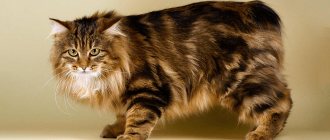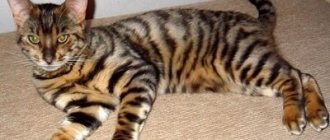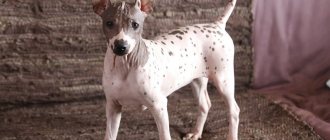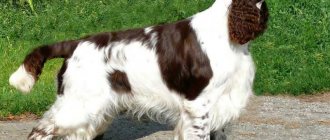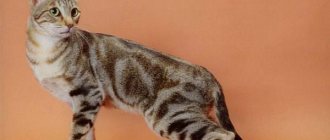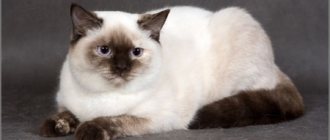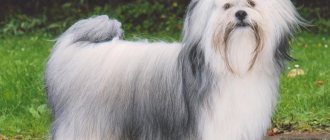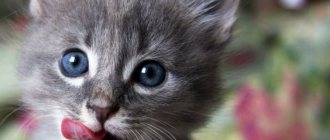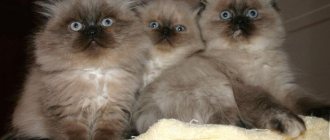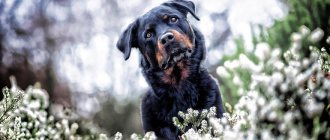Video
* We invite you to watch a video about the Toyger . In fact, in front of you is a playlist in which you can select and watch any of 20 videos about a given cat breed by simply clicking on the button in the upper right corner of the window. In addition, the material contains quite a lot of photos. By looking at them you can find out what a Toyger looks like.
In this article:
|
Rate the material!
[Total votes: 0 Average: 0]
British and American breeds
The brindle color of the British cat attracts many breeders. Representatives of this breed have an obstinate character and the appearance of a fabulous Cheshire cat. The animal requires a lot of free space for constant movement and a separate place for privacy. The purchase price at the nursery is about 10 thousand rubles.
The American Shorthair is an active and strong cat, ready to jump and play all day long. Tiger stripes can be any color. Long-lived among domestic cat species.
History of the origin of toygers
Toygers can definitely be considered a breed of American origin, the ideological inspirer and founder of which is a Los Angeles resident named Judy Sugden.
Fun fact: Judy's idea was that she wanted to breed a cat with a tiger-like appearance. Of course, all this was planned for a reason, because Judy’s mother is the founder of the Bengal cat breed, so her daughter had experience and a close person to look up to.
Toygers can be called a complex breed, a kind of “assorted cat”. Bengals, domestic short-haired cats, and ordinary mongrel cats were used to breed them. The ancestors of the first toygers and carriers of the tabby genotype are considered to be the domestic cat Scrapmetal and the Bengal cat Millwood Rample Spotskin. This couple also includes a stray cat named Jamma Blue, whom Judy brought from Kashmir.
The Toyger breed officially registered in 1993 and included by TICA specialists in its animal registry, although its existence was known back in the late eighties. It was only in 2000 that Toygers were given the status of a new cat breed, although for many years breeders made numerous attempts to breed the ideal tiger cat. And since 2007, these cats have received the right to participate in various exhibitions (but not all) and championships.
After 8 years, the GCCF (Governing Council of Cat Fanciers) became interested in these cats, and since 2021, toygers have been able to participate in international exhibitions, organized by the world’s oldest felinological association.
What kind of breed, how did it come about?
Tiger cats are very interesting and mysterious creatures. Thanks to their unusual coat color, some of them resemble small tigers, others resemble leopards and even jaguars. Some tiger breeds have remained alive in the wild, but the majority have long been domesticated. There are also artificially created breeds that are quite expensive. Next we will talk about the most common breeds of tiger cats.
Tiger cats (lat. Leopardus) are a genus of the cat family, the order of carnivores. The Latin name of the genus has nothing to do with leopards; tiger cats are classified as a subfamily of small cats. They are distinguished by gray or yellowish-brown fur, which necessarily has patterns in the form of stripes or black spots. All representatives of this genus live in the New World, most of all in Central and South America.
The tiger genus dates back a very long time. These were wild cats that lived in different parts of the world. And today some representatives of the genus remain among the wild. But there are varieties created artificially.
Toyger - description of the breed
Felinologists believe that a toyger that meets all breed standards should have a weighted front part of the body and clear stripes of maximum contrast, beautifully decorating the cat's fur coat. Compared to other cats, the grace and refined figure of the toyger is considered a big disadvantage; the ideal of the toyger corresponds to a very energetic and powerful cat-athlete, who is always active and cheerful.
Many ignorant cat lovers can easily confuse a Toyger with a Bengal, although they have a number of distinctive features.
They appear:
- In the structure of the figure (physique);
- Coat color;
- Character (habits and disposition).
The toyger is characterized by more impressive dimensions, an elongated body and rich stripes on the fur coat, which are located vertically. Cats of this breed are more massive and more interesting than cats that look fragile and do not have such developed muscle mass. In females, there is often a lack of spectacular feathering, which in cats is found in the temporal zone and in the chin area.
The weight of male toygers varies from 5 to 7.5 kg, and cats can weigh from 3.5 to 5 kg. The broad-boned figure with well-developed muscles gives this breed a wild and exciting appearance. The cat's head is of medium size, its contours are well defined, and the muzzle is elongated; it is distinguished by rather elongated cheekbones. The toyger has a rounded and strong chin and clearly visible pads on which the whiskers are located, because of which the animal’s muzzle resembles an inverted heart.
The toyger’s nose is also solid, closer to the tip it becomes wider and ends with a large lobe, but not deep, the bridge of the nose has a rounded shape. Cat eyes are small or medium in size and are distinguished by deep-set eyeballs located at a slight angle. The iris has a yellowish-green color. Toggers' ears are small, set wide apart, their tips are rounded; there should not be too large or long tassels on the ears.
The toyger is quite massive, its entire body is strong and elongated, its shoulders protrude forward, supporting its heavy, broad chest. These cats have fairly strong paws of medium length; they give the figure a greater resemblance to tiger relatives. Cat toes, on the other hand, have good length and flexibility. The toyger's tail looks like a long and dense rope, the tip of which is rounded.
Bengal and Egyptian Mau
The Bengal breed was the result of artificial mating of a wild leopard cat with outbred Californian cats in 1963. The breed was registered in 1983 and is more common than the Toyger.
Egyptian Mau are spectacular cats with short hair and slender legs, with the grace of a queen and large eyes. The four subspecies include smoke and silver with black spots, honey and sand with brown leopard patterns.
When a sacred pet died in ancient Egypt, it was buried with honors in the family crypt or in a separate animal cemetery. The embalmed feline was accompanied to another world by mummified mice.
Popular toyger colors
If we talk about the animal’s fur coat, it should be noted that toygers are classified as short-haired cats, but their fur is densely packed, soft and has a beautiful shine. The cat's outfit is also distinguished by an ultra-modern 3D effect, which consists in the fact that the fur of the stripes is longer than the background hair, which gives the pattern volume and depth. Let's take a closer look at the color characteristic of the breed.
So, the color of toygers is called brindle (mackerel), characterized by vertical and contrasting stripes, which stand out beautifully against the general background of a golden-reddish color. According to the standards, the color of the cat's background should not be uniform; there should be lighter areas in the abdomen, on the inside of the limbs, and on the chest. The main thing in the color of a toyger is the presence of maximum contrast between the light areas, the tiger pattern and the overall tone.
The main difference between this breed is the presence of unique tabby stripes, which can have the following shades:
- Dark, almost black color;
- Dark brown (chocolate) color;
- Brown;
- Yellowish brown.
It is worth noting that the hair on the strips is all the same color, from the very ends to the skin of the animal. The mouse color of the cat's undercoat is allowed, but the overall background must be monochromatic. For a toyger, it is mandatory to have a vertical tiger pattern that can intertwine and wriggle a little.
Interesting fact: When looking at toygers, one cannot help but notice the circularity of the stripes, which close in the neck, tail and paws. The pattern should run across both the stomach and the inside of the limbs.
The pattern on the cat's face should be circular; vertical stripes between the back of the head and the nose are not desirable. In the forehead area there is a dark ornament similar to the figure of a butterfly. It is very appreciated when a cat's eyes and lips are framed with a black border, and black dots stand out on the pads where the whiskers are located.
The lightened fur around the eyes resembles white glasses, and light spots like fingerprints stand out on the dark ears. The tip of the cat's tail and pads on its paws should be black according to the standard.
It is definitely worth mentioning that there are silver (snow) toygers; they have been sold for quite a long time, but are not standardized. These cats have an almost white (light cream) background and light brown stripes. The fur of snow toygers is softer than that of brindles.
Appearance
The Toyger is a massive cat, reaching up to twelve kilograms in weight. Large, with large bones and heavy paws, it is a real predator. The standard prescribes the following characteristics for the breed.
Head.
Elongated, heart-shaped muzzle. Rounded ears. Small, deep-set eyes with half-lowered eyelids are distinguished by rich colors. Elongated nose, widening towards the end.
Frame
Low and long body, wide neck and chest. Powerful athletic paws. A wide, downturned tail with a rounded end.
Wool
Short, plush fur with a rich golden sheen. The pattern is “relief”: dark hairs are longer than light ones. The undercoat is soft and uniform. There is no ticking.
The main feature of the toyger is a modified tabby mackerel, a rare striped color. The main background is always contrastingly different from the color of the stripes.
The pattern consists of clear and bright vertical stripes covering the entire body and paws. The tip of the tail and paws are black. Stripes also cover the face. There are white “glasses” around the eyes.
Character and habits of toygers
Toygers can be called balanced and moderate; they do not like to rush to extremes. Cats treat their household members kindly, but do not show excessive annoyingness. Toygers are very energetic and active, but they will not rush around the house at the speed of light. In general, these striped creatures can confidently be considered good-natured and sympathetic. These tiger cats have one important trait, which is called curiosity; they try to carefully study all the space around them and are always very interested when they see something new.
You will not see in Toygers excessive pride, independence and resentment, which are characteristic of many other cats. Toyger will not hold a grudge or be offended for a long time. He will forgive his owner all unpleasant incidents: being given medicine, injections, his tail, which was accidentally stepped on. The toyger is always loyal, but not timid, these cats are not particularly cowardly, they are not only curious, but also brave, so they can get into some kind of trouble (for example, a showdown with a dog and another cat).
Toygers are extremely sociable and trusting. They are able to show their affection to anyone who shows even a drop of interest in them. “Tiger cubs” love to play with their owner, his children, other household members, and just acquaintances who drop by for a visit. A special sign of the highest respect and attention to the owner is considered to be a cat massage, which toygers simply love to do, climbing onto the owner’s lap or stomach, fingering them with their clawed paws and purring soothingly.
Interesting fact: These cats do not like to be alone, they are always ready to hang out with you, to be aware of all household chores. Left alone, the toyger will be bored and perceive this loneliness as imprisonment or some kind of punishment.
Toygers are quite smart and can be easily trained using standard methods; they can easily be included in the training process and quickly understand everything related to prohibitions and permissions. Toygers easily learn to go to the litter box, are very clean by nature, and love order to reign around them.
Character of domestic "tigers"
Domestic brindle cats are usually calm, self-sufficient, curious, and love attention and affection. From such cats you cannot hear the usual cat meow. The sounds they make are reminiscent of birds chirping. Kittens are very active, playful, and enjoy communicating with everyone who pays attention to them.
Adult animals are smart, tolerant of children, loyal to their owner, not jealous, and get along with other pets: dogs, cats, birds. The black tiger cat lives a long time, does not need special conditions and feels good in a small room. Its lifespan is about twenty years.
Interesting facts about toygers
You can talk about the amazing Toyger cats for hours; there are quite entertaining and interesting facts about these tiger favorites.
Which we will share with you:
- The breed was bred in 1993 in the United States by the daughter of Jane Meal, who at one time became the founder of the Bengal breed;
- Toygers appeared on the territory of our country only recently, in 2008; at present there are 6 nurseries in Russia;
- This cat breed is not numerous, therefore it is prohibited to cross Toygers with other cat breeds;
- Toygers have an unusual habit typical of dogs; they love to lick the hands of their household members. Apparently, this is how they express their deepest gratitude and respect;
- The Toyger is considered the youngest, most expensive and rarest cat breed, bred for those who dream of having a miniature tiger cub as a pet;
- Toygers consider their most favorite and unusual pastime to be spending time on a running wheel, where they spend a lot of strength and energy, which sometimes overflows;
- In some respects, toygers can be compared to dogs; they are easy to train and can carry out commands such as “lie down”, “sit”, “come to me”, which is not typical for cats. “Tiger cubs” love to engage in fetching, bringing in their teeth objects thrown by the owner;
- Toygers are not at all embarrassed by the harness; they easily adapt to it for going for a walk;
- The struggle for a leadership position with other pets living with the toyger under the same roof is not typical for these cats; jealousy and envy do not overcome them. Toygers can calmly contemplate how they look at another cat and not experience any irritable or negative emotions;
- It has been noticed that most toygers are not afraid of water at all.
Appearance
These cats are the embodiment of power and grace. Toygers are quite large pets, they have expressive facial features - a large chin, bright, attentive eyes, neat ears. Representatives of the breed have a peculiar physique. The body of these cats is somewhat elongated, the limbs are strong and slightly short, in general the cat gives the impression of a strong and agile pet.
The main feature of these cats is their specific striped color. Dark, clear stripes stand out well against a light background and form a beautiful pattern, which makes these cats look like little tigers. This color is called tabby mockerel, but Toygers have their own version of this coat pattern. The stripes are located on the torso and limbs, as well as on the head. Neat elongated spots are acceptable.
The name of the Toyger breed comes from two English words “toy”, which means “toy” and “tiger” - from English “tiger”.
These cats are shorthaired. Their hairs are soft, silky, with a very beautiful silver tint. The vibrissae (sensitive hairs) are quite long and thick, and the anus are dense, which gives them a somewhat menacing appearance of a predator. Despite their exotic wild appearance, Toyger cats are gentle, friendly, and this is easy to read in their facial expressions.
Pros and cons of toygers
Each breed has its own advantages and disadvantages, which are not spared by Toygers. Naturally, for their owners, these tiger seals are simply the embodiment of an ideal, but, looking from the outside, you can also see some shortcomings. Let's try to understand all these subtleties, characterizing both positive and negative cat traits.
The advantages include:
- Good nature and sociability, which attract attention and contribute to the rapid adaptation of the animal (kitten) to the new family;
- Moderation in actions makes toygers balanced and restrained, and the owner can be calm that the home will not suffer from cat games, at least there will not be too heavy damage;
- A decadent and depressive mood is not typical for toygers; they always maintain self-control and vigilance;
- Cats are easy to train and train;
- Toygers are unpretentious in keeping; they do not require any specialized care;
- Spectacular appearance of tiger cats;
- Toygers get along quite calmly with other pets and can even form friendly relationships with them.
The breed also has its own shortcomings that those who are thinking about getting a Toyger need to know.
Disadvantages of the breed:
- Over-curiosity, which in some cases can harm seals trying to stick their nose where it shouldn’t;
- Excessive gullibility can also play a cruel joke on toygers, because these cats can happily make contact with a stranger who paid them at least a little attention;
- A slightly nasty cat's voice can be considered a drawback, but a very tiny one, because... these cats prefer silence;
- Uncastrated cats and mature female cats place marks with ecstasy and care, indicating their possessions;
- The huge cost of toygers due to their small numbers should also be considered a disadvantage.
Coat and colors
Today the brindle color is commonly called “tabby”. It covers the entire body of the animal with stripes, like a tiger, or spots, like a leopard. In this case, the main background can be anything.
Most often, tiger cats have fur of a brown or beige background. The stripes on them are brown, dark red or black. Gray and silver representatives, which do not at all look like predators, were also noted. Some brindles can be tortoiseshell or calico in color.
There are cats with a brindle pattern among short-haired and long-haired breeds. Sometimes kittens are born without stripes, but after 2-3 weeks the stripes definitely appear, but the final formation of color sometimes takes months. The brindle color is surprisingly varied and can combine various elements of pattern, background color, spots and stripes. Since the list of all types of this varied color is quite large, we will consider only the most interesting and common breeds of tiger cats.
Toyger breeding
Breeding toygers is a labor-intensive task; this is done by professional breeders in specialized nurseries. There are only three such nurseries in the vastness of our country. Breeding work is carried out using the system developed by Judy Sugden (the creator of the breed).
Interesting fact: It is practically impossible to purchase a breed-class kitten; such cats are found only in nurseries and are used for breeding on their territories.
We sell already sterilized kittens belonging to the pet class. If you have been offered a cat or a breed-class cat, you should think about it and not trust such an offer, which may turn out to be a scam.
As already mentioned, animals of only one breed are used for crossing; breeding work with other types of cats can be dangerous to the health of toygers, because from them the animal can accept not only positive, but also negative traits for the breed. Nurseries are always in interaction with each other, collaborating with other qualified breeders from different countries.
Experts assure that the Toyger breed is extremely difficult to work with, and only professionals can breed it. An ordinary person cannot officially (legally) purchase a toyger who has the right to further reproduce offspring; this can be done by a person with a felinological education or with recommendations given by famous breeders. Catteries are trying to eliminate unqualified matings of cats by selling already spayed and neutered kittens that do not have the right to breed.
Health
Typically, wild-type animals are very resilient and disease-resistant, unlike their bred counterparts. Modern genetic studies have shown that the T gene, which determines the brindle color, is directly related to immunity.
Artificially created breeds, more than the descendants of their “wild” counterparts, are susceptible to diseases such as:
- cardiomyopathy;
- cardiac hypotrophy;
- cataract;
- feline leukemia.
The rest of the “tiger cubs” mostly suffer only from the same diseases that ordinary domestic cats suffer from:
- colds;
- infections;
- poisoning
Caring for Toygers
Toygers are unpretentious tigers; even brushing cats can be done irregularly, because they shed only once a year and very slightly. Massaging with a brush can be done for the cat's pleasure, but it will also be beneficial for hair growth. There are no problems with water procedures either; cats treat them favorably and are not afraid of water. It is quite possible for one person to bathe a toyger without any help.
Once every couple of days with cats you need to brush your teeth. It is imperative to regularly inspect the animal’s ear canals and remove excess wax accumulations using a moistened napkin or cotton pads soaked in a special lotion. Twice a month, the toyger receives a pedicure with a nail clipper; otherwise, they can polish their own claws using a scratching post.
It is worth noting that it is better to take toygers out for a walk using a harness, because pets can behave with some recklessness and try to run away (for example, when they see a dog). Toygers, like many cats, do not have a special place in the house; they occupy all the space, lying down and placing themselves wherever they want. Of course, a cat may have his own bed, but he will most likely prefer the owner’s sofa or bed to it.
It should be noted that flower growers will have a hard time, because toygers will definitely show interest in the plantings, which will have to be constantly protected and monitored. Toyger owners have noticed that cats of this breed are more sociable and obey their owners in everything, and cats are characterized by self-will and some independence, but this depends on their upbringing. With proper care and attention, toygers live about 15 years, but can live up to 18.
Breeds of cats with brindle color
Tiger "savage" oncilla
This tiger cat still lives in the wild today. The oncilla is larger than the average domestic cat, but among other wild cat breeds it is the smallest representative. As a rule, oncillas have yellow-gray fur with stripes. These “savages” are not afraid of water and swim well.
Externally, the oncilla resembles a miniature jaguar. Its coat is short, on the surface there are characteristic tiger stripes, consisting of spots closed in rings. Habitat: mountain evergreen moist forests of the tropics, eucalyptus thickets and thorny shrubs, savannas, subtropical forests. Oncilla often settles near populated areas, in eucalyptus plantings.
It is difficult to distinguish an adult oncilla from a baby jaguar. Their characteristic appearance and beautiful fur attract poachers, as a result of which the oncilla population is gradually declining. The breed is endangered, so hunting for oncills is prohibited in most of their habitat.
Considering the price of the oncilla, as well as its whimsical nature, it is worth considering several times whether you can keep such a wild animal in appropriate conditions so that it not only pleases your eye, but is also quite happy. If you have the opportunity to provide a wild cat with a free enclosure and your care, then you can safely acquire a new friend, because the beauty of its color can amaze anyone.
Toyger - miniature tiger
Many domestic cats have brindle stripes. The most popular brindle pet breed is the toyger. If translated from English, the name means “toy tiger.” This animal is one of the best exotic breeds; its cost is very high. Therefore, it is believed that the presence of a toyger in the house gives it a special chic and is a sign of the owner’s material well-being.
Scientists have been searching for ideal parents for breeding the tiger breed for a long time. As a result, she was created by crossing an ordinary cat and a Bengal cat. But the appearance of the toyger is like that of a real tiger. Only much smaller in size. Outwardly, he looks very graceful and aristocratic.
The body structure of such cats has its own characteristics. They themselves are quite large, their body weight reaches 6-8 kg, but they have a long and thin tail, as well as small paws. The toyger has an elongated muzzle and a wide nose, which is unusual for ordinary cats. The pet has a powerful neck, small ears and large blue eyes.
Tiger stripes on the body can be of different shades - black, yellow, brown. The paws and tip of the tail are always black. Such animals are short-haired. As for character, the brindle cat is very affectionate, calm, and loves to be given a lot of attention. It is worth noting that toygers make not only standard cat sounds, but others that are similar to bird sounds. Little kittens are active and playful. Adult pets are calmer, smarter, and devoted to their owner.
In addition, the black tiger cat lives quite a long time. Its lifespan can reach 20 years.
Bengal cat - domestic leopard
This cat breed is quite rare and is also of artificial origin. Bengal cats were created in 1963 in California by crossing wild leopard cats with domestic cats. Long-term work on the breed and use in breeding other breeds has led to the fact that now the leopard color of Bengal cats is characterized by chaotically scattered spots on the coat of not only black and brown colors, but also various others. Official recognition of the breed took place back in 1983, and therefore the breed, although quite rare, is much more common compared to Toygers.
However, Bengals have a few funny mannerisms left from their wild ancestors. For example, they are not at all afraid of water, like all other cats. On the contrary, they love to swim in some pond or in your bathroom. Their way of drinking water is also funny - before they start lapping from a bowl, they can move their paw through the water, dispersing imaginary mud. These cats are also unique in that they do not meow, but make strange sounds that are only vaguely reminiscent of the meowing we are used to.
It is also worth mentioning that the Bengal cat has unusually high intelligence for cats. This is one of the smartest breeds! You can teach them to follow simple commands without any problems. They are very cheerful and energetic. They don't like lying around on a couch all day long. But they love to run, jump, play with the mouse and are constantly trying to keep themselves busy with something.
Bengals behave warily around strangers. They won’t let a stranger pet them so easily. You must first gain their trust, and only after that they will show you all their affection and care. In general, this is a very kind and loyal breed that will delight you every day.
Egyptian Mau - ancient leopard-colored cats
The history of the breed begins in Ancient Egypt, where these cats were considered sacred. Egyptian Mau are short-haired cats with elegant body shapes, large eyes and longer front hind legs. There are four officially registered subspecies of the Egyptian Mau, which differ in coat color and markings. Thus, they distinguish: smoky coat color and black spots, silver coat color with charcoal-colored spots, honey color coat with dark spots, pale yellow coat color with dark gray or brown spots. These are very reminiscent of leopards.
The character of the Egyptian Mau certainly does not resemble tigers or leopards. On the contrary, they are affectionate, playful and loyal. Also, these cats simply love to climb trees or other high places, and therefore it is very good if there are such cats nearby.
Toyger diet
Experts on this cat breed have not developed any specific recommendations and conditions regarding cat feeding. Some owners prefer dry food, while others treat their toygers with natural food. One thing is for sure: toygers are not gourmets and are always not averse to having an extra bite of something tasty.
Dry feeding is used more by busy people, because it is much easier to feed cats this way; the specialized food contains all the necessary mineral and vitamin supplements that mustachioed pets need so much. The main thing here is to choose the right food.
Feeding with natural food requires more time, although toygers are unpretentious in this regard and do not require any delicacies.
Their normal diet should consist of:
- Lean meat;
- Offal;
- Vegetables;
- Kash.
It is worth noting that these cats happily consume vegetables and cereals if they are lightly seasoned with meat or offal. It is very difficult to ensure that natural feeding is perfectly balanced, so you definitely need to give your pet separate mineral and vitamin supplements, so you should be prepared in advance for such additional expenses.
Interesting fact: Cats can be obese, so you should be more careful about their menu and frequency of meals. Experts advise feeding toygers with dry food twice a day and also feeding toygers with chicken breast, boiled pork and veal hearts. Experienced owners do not recommend giving these cats fish.
Cost of a kitten
Purebred Toyger kittens should be purchased from professional nurseries.
The breed is quite new and is not yet very widespread. More often, kittens are brought from abroad, mainly from America. Therefore, the price for these pets is high, but depends on the class:
- pet (without documents) – from 300 to 600 dollars, with a pedigree – at least 700 dollars;
- brid – from 1200 dollars;
- show – prices start at $1,500.
Diseases and health problems
The impression that toygers are cheerful and active is not deceptive; these cats really have a storehouse of energy and excellent health. They are not prone to allergies, digestive problems or dysbacteriosis, although such complications are considered regular in other cat breeds.
Mating of cats, which is carried out exclusively by professionals, is carried out under careful control, so all risks of hereditary diseases are minimized. Experts say that toygers did not inherit the genetic diseases of their feline ancestors.
Of course, tiger cats can become infected with standard infectious diseases common to all cats.
Therefore, it is imperative and timely to get vaccinations that counteract:
- Rabies;
- Calicivirus;
- Rhinotracheitis;
- Panleukopenia.
It should be noted that these felines tolerate both vaccination and deworming procedures well. It must be remembered that the closest relatives of Toygers, Bengals, often suffer from HCM (hypertrophic cardiomyopathy), which affects their cardiac activity.
This disease can cause diseases of other organs and even lead to death. The disease is insidious and dangerous because it cannot be diagnosed in the early stages. In this regard, the descendants of Bengal cats (Toygers) are recommended to regularly conduct ultrasound examinations of the heart and do an ECG. Of course, the possibility of this genetic disease occurring in Toygers is extremely small, but still, it exists, so you need to be fully prepared.
We should not forget that tiger cats are susceptible to obesity, because... They will never refuse an extra snack, so you need to carefully monitor their cat menu to avoid this problem of excess weight.
Diseases
No genetic diseases have been identified in this breed, and no serious diseases have been reported either. The most your pet can suffer from is a common cold. Therefore, make sure that the animal does not lie in a draft and does not freeze after bathing.
Vaccinations are required if you love your pet and want him to be healthy. Even if you do not let your cat go for walks, pathogens can easily be brought home on your own hands (if you stroke the animal with unwashed hands), but on the soles of shoes or street clothes.
Rabies, rhinotracheitis, panleukopenia, calcivirosis are deadly diseases from which the animal must be protected. Currently, there are a number of complex vaccines (which contain not one, but several components), which are administered from an early age (6-10 weeks). Repeated vaccinations are given once a year. Popular vaccines on the domestic market: Nobivak (Tricket and Forcat), Quadrikat, Leukorifelin, Multifel-4, Fel-O-vax), Primucel.
Expert opinion
Dusheba Vera Ivanovna
In 2010, she graduated from the Moscow State Academy of Veterinary Medicine named after K.I. Scriabin with honors, specializing in veterinary medicine. I regularly attend veterinary conferences, congresses, and webinars.
Before vaccination, be sure to give your cat anthelmintic medications. But not human ones - they will cause poisoning! - and special ones, for animals. Before purchasing the drug, be sure to consult your doctor. It is impossible to drive worms from pregnant cats (in the first half of the term), in the presence of infectious diseases, pathologies of the urinary system and liver, as well as in kittens under 6 weeks of age.
Feeding "toy tigers"
The Toyger cannot be called a hybrid cat, but it still has some needs and characteristics of hybrids. In particular, this is a shortened intestine. Therefore, he needs to select food and food based on this factor.
Industrial feed
It is allowed to feed a toyger only with holistic, premium and super premium food. Brands suitable for cats of this breed:
- Acana Grasslands (Canada, super premium class). One of the most famous foods in its class. The food is balanced, has the optimal amount of fat and protein (35% and 20%, respectively). The product is grain-free. Feed composition: lamb meat (8%);
- duck (8%);
- eggs (8%);
- herring (8%);
- turkey (8%);
- lamb liver (5%);
- pike (4%);
- pollock fat (2%);
- lamb fat (2%);
- pumpkin;
- chickpeas, lentils, green peas;
- apple;
- berries;
- carrot;
- pear;
- medicinal herbs;
- useful microelements and substances (iron, zinc, selenium, copper, magnesium, phosphorus, taurine, etc.);
- Omega 3 and 6 fatty acids;
- fiber (3%).
- chicken (9%);
- fresh chicken meat (44%);
- salmon (46%);
- chicken;
The following foods are suitable for kittens:
- Wahre Liebe “Junge” (Germany, super premium class). Food for kittens containing colostrum. Can be given from 2 months. Normalizes stool, improves the condition and growth of hair. Ingredients: chicken (26%);
- turkey (4%);
- chicken liver (1%);
- poultry fat;
- flaxseed (1%);
- desugared beets (3.5%);
- salmon oil (2%);
- colostrum (0.5%);
- medicinal herbs;
- egg.
- fresh turkey fillet;
- proteins - 36%;
Photo gallery: food for toyger
The Acana line of food (Acana Wild Prairie and Acana Grassland) is suitable for both adult cats and kittens from six months of age
Acana Wild Prairie food has a varied composition
AATU food consists of 85% chicken meat
Canidae food is not cheap, but is of exceptionally high quality.
Carnilove food is fundamentally different from other foods: it is created specifically for hybrid cats, it contains all the products and microelements that animals receive in the wild.
German food Wahre Liebe contains colostrum and is available in dry and wet versions
NOW food is made in the USA and made from fresh meats
Royal Canin Kitten food is perfect for kittens due to its balanced composition
Natural nutrition
Natural food for a toyger should consist of the following products:
- liver (lungs, kidneys, heart, liver);
- bird necks - especially useful during the period of changing teeth (free from skin and fatty streaks, crush with a hammer);
- sea fish without bones - 1-2 times a month;
- raw quail eggs - once a week;
- raw or boiled vegetables (cauliflower, zucchini, carrots, spinach, pumpkin);
- cereals (buckwheat, barley, rice);
- low-fat cottage cheese (toygers eat other fermented milk products without appetite);
- sprouted wheat.
Product proportions:
- 70% - meat;
- 15% - vegetables;
- 5% - cereals;
- 10% – offal, cottage cheese, eggs, fish.
Meat and fish must be boiled to avoid infection with worms.
Maintenance and care
These wonderful cats are suitable for people who do not have time for systematic daily animal care. Toygers require classic care - the most suitable food for your pet, and occasional brushing of the coat with a special brush. In addition, we must not forget about brushing teeth and trimming nails.
Experts believe that during selection, toygers lost the instinct to find a trace. Therefore, try not to lose the little “tiger”, since he will not be able to find his way home on his own.
Reviews
Alina:
“I didn’t intend to get a cat, but after seeing this miracle on the Internet, my opinion changed. I really wanted her. It was difficult to get. We contacted the cattery, but we had to wait 3 months for a kitten. When I saw him, it was love at first sight. The sweetest creature, with big, kind eyes. The stripes really look great. As the cat grew, it became even funnier; playfulness does not disappear with age. But it becomes majestic and graceful. In general, the behavior resembles that of a tiger. We have 2 sons in our family. They torment the cat as best they can. One is 4, the other is 5 years old. Our tiger doesn’t complain about anything, he follows on their heels to play. Even my husband did not remain indifferent to him, although he had not liked cats before. In general, such a creation will enliven any home and absolutely everyone will like it.”
Olga:
“They gave me a cat, brought from England. I had never heard of the breed before, but I was told that the cat is fashionable. I immediately liked him for his funny behavior and gentle temperament. It does not scratch at all, as if there were no claws. He doesn't do any mischief. He doesn’t climb on tables, he quickly learned where the potty was, there were no problems with it. He eats everything I give. Of course, I read beforehand what he could and couldn’t do. He loves cottage cheese very much. I buy rustic, no chemicals. We take care of the cat. We rarely give dry food, but it happens. Already 6 months old, becoming more and more beautiful with age. During this time I haven’t been sick with anything, I let him go outside under supervision, and I don’t let him near other cats.”
